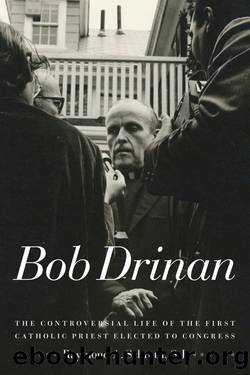Bob Drinan by Schroth Raymond A.;

Author:Schroth, Raymond A.;
Language: eng
Format: epub
Publisher: Fordham University Press
Published: 2011-08-15T00:00:00+00:00
9 âMy conscience tells me â¦â
One of the cultural icons suggested to represent the 1970sâan age when people turned inward, when personal freedom counted for more than civic responsibility, or when families broke up, and violence in films became more routine and more bizarreâwas the William Friedkin film of William Peter Blattyâs book The Exorcist. The novel and film were based, allegedly, on a true story of a Jesuit priest who drove the devil out of a child in Washington, D.C., years before. That priest from time to time gave lectures to Jesuit novices that included his encounter with Satan. The story, situated in the Georgetown neighborhood, included a renowned exorcist, based roughly on the great French Jesuit paleontologist and mystical theologian Teilhard de Chardin, and local Jesuits trying to help the little girl, who, when possessed, would be transformed into an obscene monster. She vomited green bile, spun her head 180 degrees, and, in a shocking scene, plunged a crucifix into her vagina.
Some have interpreted the film as an allegory about abortion. In this view, the possessed girl was, with the cross as an instrument, mimicking not just masturbation but abortion. The film was released in the same year in which the U.S. Supreme Court handed down its Roe v. Wade decision; and both those who supported the right to abortion and those who opposed legalized abortion had something to recognize. Evangelical preachers have argued that sexual promiscuity and abortion can open the door to let the devils in. Traditional Catholics took the film as a parable: Yes, there is a real, living devil, an evil spirit, who can get inside you, take you over, and make you sin. Liberal theologians suggested that Satan is a metaphor for the evil already in our hearts; we need no âoutside agitatorâ to overpower us; our own lust and greed are enough to explain evil in the world. For those threatened by social change, neighborhood crime, and sexual depravity, the film gave the comfort of attributing it to an invading spirit. To liberals, the faults were in failed social structures and in ourselves.
Prior to Roe v. Wade, the abortion debate was complex, and many excellent articles and books dealt with the issueâs ambiguity. Moralists struggled for formulae that would meet the issues raised by both sides and yet protect some basic human values essential, it would seem, to communities that, at some stage, had taken their values from the Judeo-Christian tradition. After Roe v. Wade, for a variety of reasons, the discussion became polarized. For the leadership among the American Catholic hierarchy the argument became centered on the federal government and the U.S. Supreme Court. Their strategy was to elect representatives who would overturn Roe v. Wade, either by passing an amendment to the Constitution outlawing abortion or by electing a president who would appoint to the Supreme Court justices committed to overturning Roe. Those political leaders who rejected this plan, for whatever reason, especially if they were Catholics, were labeled by the extreme anti-abortion faction as immoral, worthy of being excluded from communion.
Download
This site does not store any files on its server. We only index and link to content provided by other sites. Please contact the content providers to delete copyright contents if any and email us, we'll remove relevant links or contents immediately.
The Secret History by Donna Tartt(18865)
The Social Justice Warrior Handbook by Lisa De Pasquale(12143)
Thirteen Reasons Why by Jay Asher(8802)
This Is How You Lose Her by Junot Diaz(6804)
Weapons of Math Destruction by Cathy O'Neil(6155)
Zero to One by Peter Thiel(5694)
Beartown by Fredrik Backman(5610)
The Myth of the Strong Leader by Archie Brown(5429)
The Fire Next Time by James Baldwin(5253)
How Democracies Die by Steven Levitsky & Daniel Ziblatt(5134)
Promise Me, Dad by Joe Biden(5090)
Stone's Rules by Roger Stone(5029)
A Higher Loyalty: Truth, Lies, and Leadership by James Comey(4852)
100 Deadly Skills by Clint Emerson(4845)
Rise and Kill First by Ronen Bergman(4706)
Secrecy World by Jake Bernstein(4653)
The David Icke Guide to the Global Conspiracy (and how to end it) by David Icke(4629)
The Farm by Tom Rob Smith(4443)
The Doomsday Machine by Daniel Ellsberg(4421)
